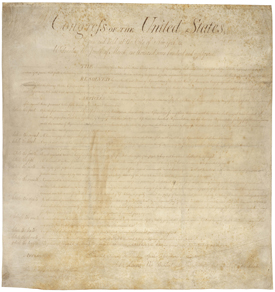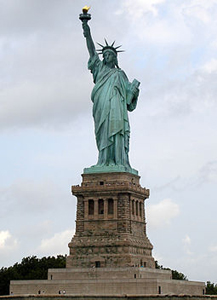The First Amendment

Freedom Of ...
Most of us remember the First Amendment (one of ten ratified December 15, 1791) to the U.S. Constitution. Congress actually titled this as "Article the third" of the twelve submitted to the states for ratification. But have we really read the words carefully?
The first premise in this article/amendment is stated as "Congress shall make no law respecting an establishment of religion, or prohibiting the free exercise thereof".
While we often initially think of the First Amendment as dealing first with freedom of speech, it begins instead with freedom of religion. The single two letter word "of" is the key word in this portion of the Amendment. In no way does it mean freedom "from" as it has been so often misquoted. The intent was that Congress would in no way establish a national religion over and above any other. At the same time, Congress would not prevent individuals from worshiping, or not, as they so chose. Their choice of religion would not be the basis for citizenship or any privileges of citizenship.
Thus, the churches were free of meddling in their internal affairs by the government. However, it does not preclude churches and government from collaborating for the benefit of the community. And, it has nothing to do with lawn decorations during holiday seasons. Those decorations fall under the second portion of the Amendment - freedom of speech. Lawn decorations are an expression of ideas more than anything else.
..."or abridging the freedom of speech, or of the press; or the right of the people to peaceably assemble, and to petition the Government for a redress of grievances."
Within commonly accepted limits - common decency, libel (injuring the reputation of another with false statements) and incitement to violence being examples of overstepping those limits - Congress guaranteed the free expression and exchange of ideas through spoken and written word, and the arts. The ideas shared do not have to be popular or in agreement with those held by government officials.
Freedom for the press is a part of the overall picture of freedom of speech. We mostly think of this as the media, which has evolved in its means of sharing news and opinions with the public since 1791. It now includes the internet and other electronic means of sharing information.
Communications spread far more rapidly today than they did in 1791, and the press (print, broadcast, and internet) is not the only body circulating information. Unfortunately, the speed with which information is shared in the 21st century often means the fact checking that was possible in 1791 falls by the wayside in 2017.
The Congress in 1789 also recognized that for freedom speech to be effective it was necessary to preserve the "right of the people peaceably to assemble, and to petition the Government for a redress of grievances."
While the right to assemble is a right, it does not preclude local governments from requiring an organized assemblage to have a permit for use of a public thoroughfare or a reservation to utilize a public space such as a park. Those do not prevent the freedom of speech. Rather they facilitate planning for the conduct of other activities associated with the location in an orderly manner.
Groups of individuals may decide they have a legitimate grievance against the government. By permitting a petition to the Government for review of the issue that the petitioners feel must be addressed, problems are brought to light and armed insurrection may be averted. The grievance stated may not be resolved immediately, but, even if the representatives of the Government vehemently disagree, it has been made known for consideration.
Side by side with the freedom to assemble is the freedom to not participate in the assembly. In other words, the Government cannot make anyone attend a ceremony or other public gathering.
Summary by Elaine Ackerson; quotes are from the document noted. The Bill of Rights can be viewed in details by visiting the National Archives website. Documents made available for downloading by the National Archives as PDF files are shared within this site for your convenience. Used as references while writing the summary were "The Know Your Bill of Rights Book: Don't Lose Your Constitutional Rights--Learn Them!" by Sean Patrick ©2013 by Oculus Books and "The Leonore Annenberg Institute for Civics - the Annenberg Guide to the United States Constitution: What It Says, What It Means" (also known as the Annenberg Classroom). Links to classroom materials about each section of the Constitution and its Amendments are found at the bottom of the Annenberg Classroom homepage.

